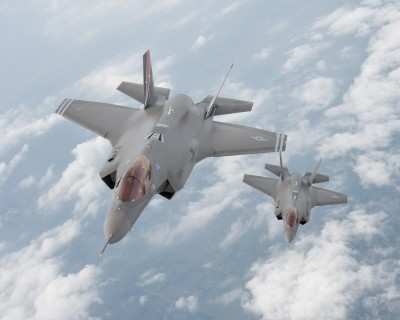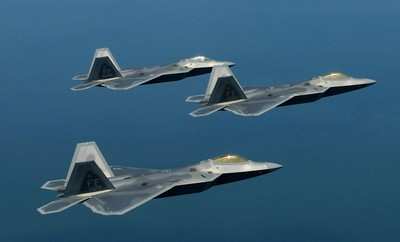Sun, Nov 23, 2014
Heat Generated By Electronic Systems A Growing Challenge
Managing heat that is generated by electronic subsystems in next-generation aircraft is a vexing challenge for aerospace system designers. In the interest of meeting this challenge, the Air Force recently provided follow-on funding for a Small Business Innovation Research (SBIR) effort that is identifying improved methods for heat conduction and rejection from system electronics for advanced fighter aircraft.

To accomplish these goals, the Air Force SBIR/Small Business Technology Transfer (STTR) program office is providing nearly $1.5 million to further mature this technology for the Air Force Research Laboratory (AFRL).
The objective of the SBIR Phase II follow-on contract with ADA Technologies, Inc., located in Littleton, Colorado, is to enhance the technology and manufacturing readiness for nano-enhanced thermal interface material grease and to integrate it with power system modules that are currently used on advanced fighter aircraft.
According to ADA Technologies' principal investigator, Dr. Sayangdev Naha, ADA's thermal grease offers "ultra-low thermal impedance at a fraction of the filler concentration compared to state-of-the-art, which enables this grease to sustain desired performance through severe thermal cycling conditions."
"With further testing, the thermal interface material grease is expected to provide a 10 degrees Celsius or better reduction in junction temperatures," said Dr. James Scofield, the AFRL researcher managing the project. "This reduction in temperature is expected to provide a direct increase in fuel cooling loop temperatures, improved end-of-mission thermal capability during ground idling, and improved reliability and cost savings."

In addition, this program leverages more than $3.95 million in additional AFRL mission funds and the independent research and development funds from the participating companies. These funds will help ensure the Phase II project graduates into a Phase III program that successfully transitions the technologies into military or private sectors.
The Air Force SBIR and STTR programs are mission-oriented programs that integrate the needs and requirements of the Air Force through research and development topics that have military and commercial potential. The SBIR program was established by Congress in 1982 to fund research and development through small businesses of 500 or fewer employees. The STTR program was established in 1992 to fund cooperative research and development projects with small businesses and nonprofit U.S. research institutions, such as universities.
Since 2006, the Commercialization Readiness Program has directly linked Air Force centers to Air Force Research Laboratory technical points of contact to identify and evaluate Air Force needs and innovative solutions. Its primary objective is to accelerate the transition of SBIR/STTR-developed technologies into real-world military and commercial applications.
The Air Force SBIR and STTR programs provide more than $300 million in funding for research and development activities by small businesses annually. With this budget, the Air Force funds research from the early stages of concept development until it transitions to military or commercial use.
(Images from file)
More News
DETRESFA (Distress Phrase) The code word used to designate an emergency phase wherein there is reasonable certainty that an aircraft and its occupants are threatened by grave and i>[...]
Aero Linx: The International Association of Missionary Aviation (IAMA) The International Association of Missionary Aviation (IAMA) is comprised of Mission organizations, flight sch>[...]
Also: EP Systems' Battery, Boeing SAF, Repeat TBM 960 Order, Japan Coast Guard H225 Buy Despite nearly 100 complaints totaling millions of dollars of potential fraud, combined with>[...]
Also: Viasat-uAvionix, UL94 Fuel Investigation, AF Materiel Command, NTSB Safety Alert Norges Luftsportforbund chose Aura Aero's little 2-seater in electric trim for their next gli>[...]
Also: Moya Delivery Drone, USMC Drone Pilot, Inversion RAY Reentry Vehicle, RapidFlight UAVOS has recently achieved a significant milestone in public safety and emergency services >[...]
 ANN's Daily Aero-Term (04.26.24): DETRESFA (Distress Phrase)
ANN's Daily Aero-Term (04.26.24): DETRESFA (Distress Phrase) ANN's Daily Aero-Linx (04.26.24)
ANN's Daily Aero-Linx (04.26.24) Airborne 04.22.24: Rotor X Worsens, Airport Fees 4 FNB?, USMC Drone Pilot
Airborne 04.22.24: Rotor X Worsens, Airport Fees 4 FNB?, USMC Drone Pilot Airborne 04.24.24: INTEGRAL E, Elixir USA, M700 RVSM
Airborne 04.24.24: INTEGRAL E, Elixir USA, M700 RVSM Airborne-NextGen 04.23.24: UAVOS UVH 170, magni650 Engine, World eVTOL Directory
Airborne-NextGen 04.23.24: UAVOS UVH 170, magni650 Engine, World eVTOL Directory




